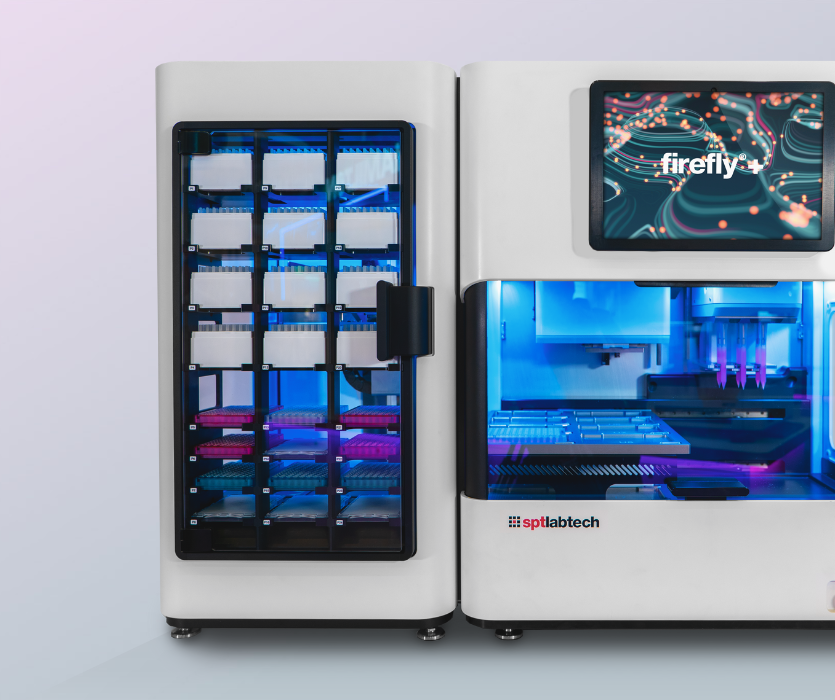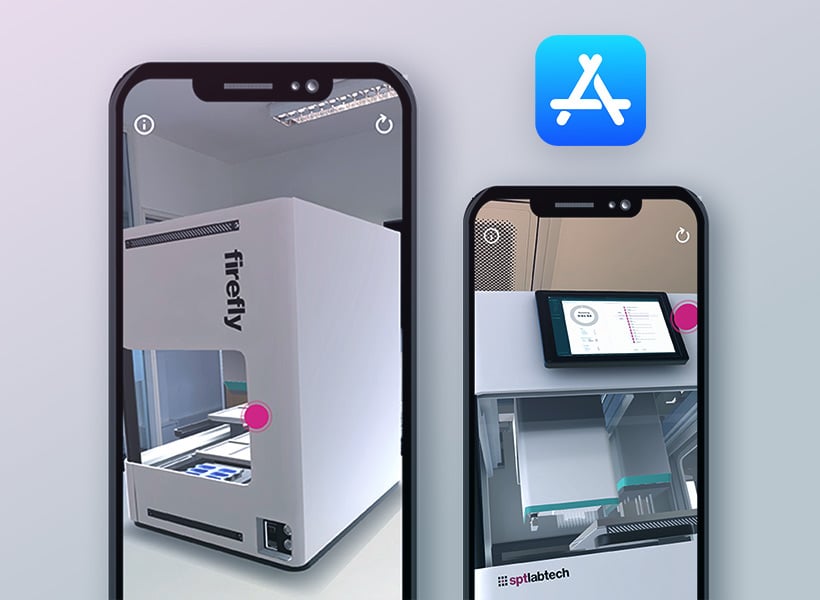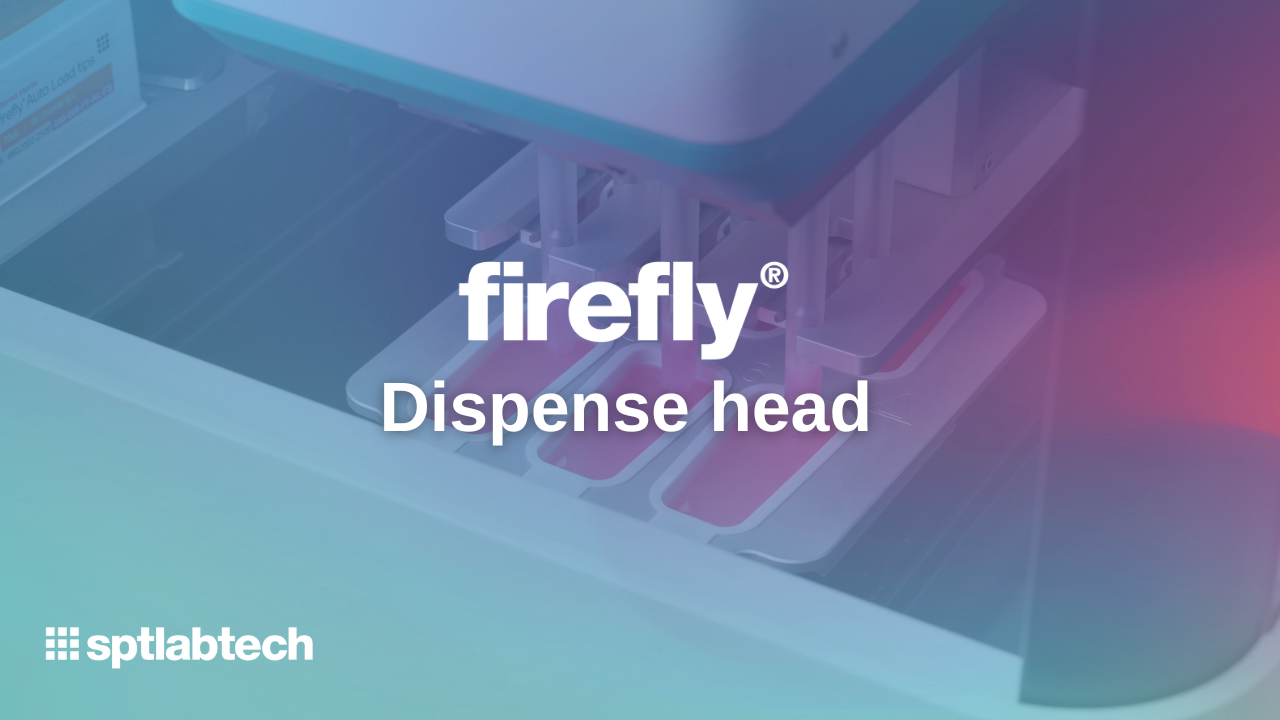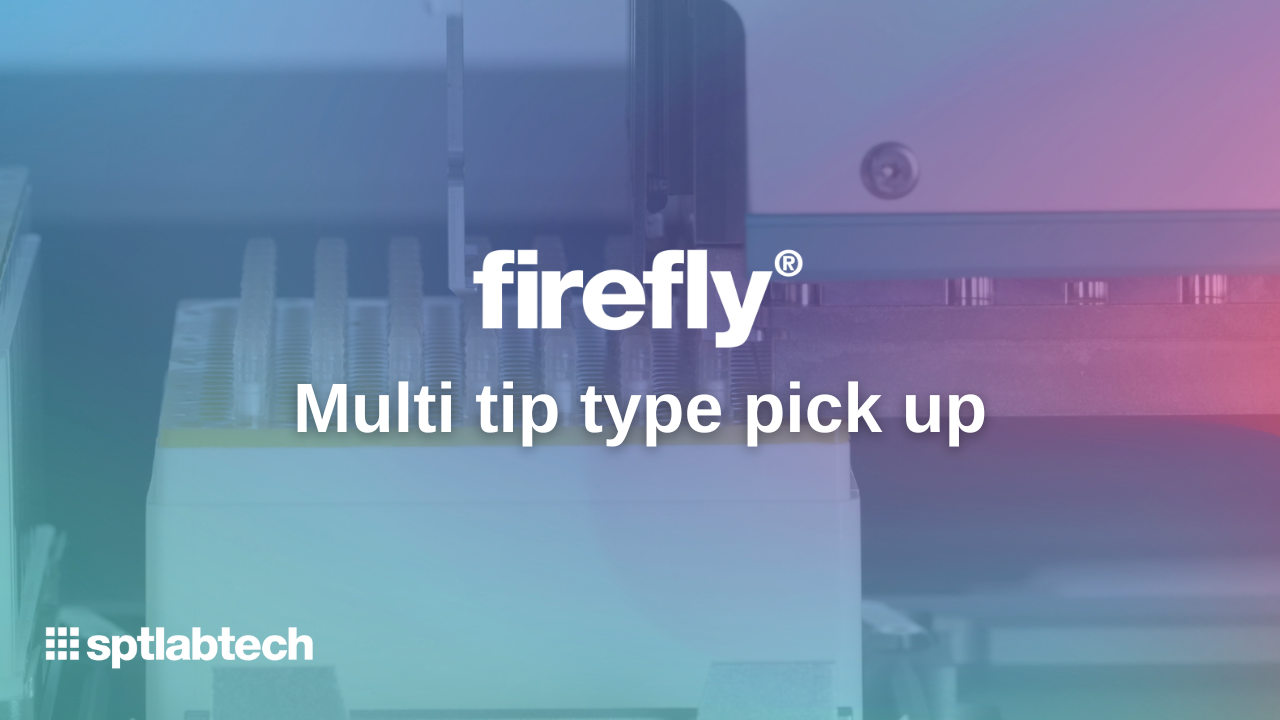.png)

- Applications
-
Products
-
Liquid Handling
- firefly Accelerate genomic research with innovative all-in-one, compact liquid handling
- mosquito Nanolitre liquid handling technology performs ‘traditional’ tasks at a fraction of the volume, and higher speeds
- dragonfly Delivers accurate and repeatable nanolitre to milliliter dispensing
- apricot Automated liquid handling instrumentation for convenient general use across your entire team
- Sample Preparation
-
Sample Management
- comPOUND A scalable, reliable, and secure compound management solution
- BioMicroLab Easy-to-use sample management automation instruments
- arktic Robust biospecimen storage and management down to -80°C
- lab2lab Novel sample and data transfer network system
- comPACT Reliable and efficient -20°C storage and retrieval has never been more accessible
-
Liquid Handling
-
About
- Company With a focus on liquid handling, sample preparation and sample management, our expert teams create state-of-the-art solutions that scientists and researchers can trust Culture We have one overarching mission: to work together to accelerate life science research. Through our innovative solutions and state-of-the-art tools, we believe we can make a real difference to human health Partners Collaboration is key in our mission to make a real difference to human health. Partnering with application leaders globally, we co-create to solve new challenges across the life sciences. Innovation From the initial prototype through to manufacturing, installation and beyond, we bring a problem-solving mindset and technical expertise to drive innovation
-
Executive Leadership
 Through strategic guidance, visionary thinking, and a relentless pursuit of excellence, our senior executives steer SPT Labtech towards achieving its mission of making a real difference to human health through solving advanced laboratory challenges.
Learn more
Through strategic guidance, visionary thinking, and a relentless pursuit of excellence, our senior executives steer SPT Labtech towards achieving its mission of making a real difference to human health through solving advanced laboratory challenges.
Learn more 
-
View all
 Board of Directors
Board of Directors
 Our Board of Directors are committed to driving the long-term success and sustainability of SPT Labtech, providing expert guidance and oversight to execute the company’s ambitious commercial strategy.
Learn more
Our Board of Directors are committed to driving the long-term success and sustainability of SPT Labtech, providing expert guidance and oversight to execute the company’s ambitious commercial strategy.
Learn more 
-
Knowledge Base
- Resources Our wide range of insightful resources include videos, whitepapers, eBooks, application notes and more Events & Webinars Meet the SPT team at events all over the globe and virtually via our webinars Podcast We chat with innovators and leaders from across the community to gain their unique insights. News Latest news from SPT Labtech globally Blog Our latest blog posts feature trends in research, innovative techniques and new technology
-
11 December, 2025
 5 Key Sample Management Automation Trends for 2025- 2026: An Interview with SPT Labtech’s Cory Tiller
Continue reading
5 Key Sample Management Automation Trends for 2025- 2026: An Interview with SPT Labtech’s Cory Tiller
Continue reading 
-
04 December, 2025
.jpg?length=320&name=SBTi%20Target%20Announcement,%20mktg%20(1200%20x%20800%20px).jpg) Delivering Sustainable Science: SPT Labtech Validates GHG Reduction Targets to Meet Customer Needs
Continue reading
Delivering Sustainable Science: SPT Labtech Validates GHG Reduction Targets to Meet Customer Needs
Continue reading 
-
20 November, 2025
 SPT Labtech enables automated PacBio Kinnex full-length RNA-seq library preparation workflow on SPT’s firefly platform
Continue reading
SPT Labtech enables automated PacBio Kinnex full-length RNA-seq library preparation workflow on SPT’s firefly platform
Continue reading 
10
- Careers
firefly – Precision Liquid Handling Automation
.png)
.png)
.png)
Maximize walkaway time with complete end-to-end automated NGS library preparation with the brand new firefly+
The firefly impact
Innovative all-in-one liquid handling brings together multiple technologies within a single compact design for more efficient library and sample preparation workflows and maximum output. Underpinned by powerful, intuitive software, firefly unlocks the potential of automation for all to accelerate genomic research.
All-in-one
firefly simplifies your genomic liquid handling workflows, combining pipetting, dispensing, incubating, and shaking technologies within an ingenious all-in-one solution.
.jpg?width=835&height=700&name=firefly-all-in-one-launch%20(1).jpg)
Compact design
firefly’s compact, streamlined design makes intelligent use of precious laboratory footprint, allowing you to do more genomics research with less space. The best things do come in small packages.
.jpg)
Peer-to-peer
firefly connects researchers and inspires bigger breakthroughs through a first-in-class peer-to-peer cloud-based network. Share custom protocols and swiftly access validated tools to deepen collaboration and accelerate innovation.
.jpg?width=835&height=700&name=firefly-peer-to-peer-launch%20(1).jpg)
Intuitive, powerful software
firefly sets a new standard in powerful liquid handling software. Its intuitive interface unlocks the potential of automation for all, putting you in control of your workflows without the need for complex programming.
.jpg)
Modular versatility
Build the solution you need with firefly's adaptable modular design. Our versatile system can evolve alongside your changing requirements, ensuring you're always equipped for success.


firefly+
Maximize walkaway time with complete end-to-end automated NGS library preparation
firefly+ expands on the current liquid handling capabilities of firefly with an integrated thermocycler and additional labware capability, all while maintaining our commitment to usability and compact design.
Book your tailored demo of firefly®
See for yourself how firefly simplifies genomic liquid handling with a personal demo tailored to your lab's workflow challenges.
Our revolutionary platform for genomics is shaping the future of NGS library prep by combining multiple technologies within a powerful all-in-one solution. A personalized demo will help you understand exactly how firefly can help you accelerate and streamline your process.
Book a demoShaping a new era of genomics research
Our liquid handling portfolio provides you with accurate and repeatable nanolitre to microlitre pipetting and dispensing, every time, irrespective of liquid viscosity or environmental conditions.
We harness innovative technology to streamline workflows and accelerate research. Robust, reliable, and easy to use, our products overcome tough technical challenges and enable researchers to focus on the best science.
- Our technology
- World class user interface
- Pipetting head
- Dispensing module
- Gripper module
- firefly+
- HEPA filter
System architecture
firefly features a 384 pipetting module and 3 or 6 dispense heads to provide flexible high performance approaches to a range of applications such as NGS library prep and PCR set up. An ingenious 2 tier moving deck system with an additional sub-deck layer for accessories packs a lot of capability into a very small footprint.
Pipetting head operates in several configurations: 384, 96, columns of 16 (384 format) and 8 (96 format) from 0.5uL to 125uL. Utilizes robust and proven air displacement technology with disposable tips and a range of tip types including gamma irradiated and filtered options.
Dispense heads provide either 3 or 6 positive displacement syringes for non-contact, liquid agnostic reagent dispensing. Syringes can operate completely independently for multiple reagent dispensing or in parallel (any combination) for speed.
The gripper module works in combination with the pipetting head and can move labware between the decks and sub-deck levels.
Optional application accessories provide greater walk-away capability with options for magnetic plates, cooling and heating tiles, and shakers.
The safety enclosure protects users from moving parts while protecting samples and reagents from airborne contaminants. A large interlocked door provides safe and easy access to load the system.
firefly sets a new standard in genomics liquid handling software with easy accessible user interface, secure log-in and audit trails, multiple user levels and intelligent programming. With cloud-based sharing and the ability to author on any PC, firefly software makes automation accessible to any lab user.
The graphical interface is extremely intuitive and accessible to users of all levels. Researchers can quickly build new protocols on any Windows PC or compatible device, even in the coffee shop! Simple drag and drop enables easy protocol set up with accessible extended features for fine tuning by advanced users. Protocols can also be locked down and tailored to provide the simplest set up for any user with clear running instructions to make the system truly accessible to anyone in the lab. Powerful audit trails and user access also ensure that methods are protected and provide tools to aid compliance in regulated environments.
firefly can be programmed and protocols executed at the instrument through the integrated tablet. The software can also be installed on external Windows-based devices to enable protocol writing away from the system. Easily share protocols with the instrument via the cloud connection, network or even a USB stick providing ultimate flexibility and convenience.
firefly software provides cloud access to a user community enabling the sharing of protocols between users and access to SPT labtech validated protocols and tools.
The pipetting head has a 384 core capable of parallel pipetting up to 384 individual samples between 0.5uL and 125uL. Disposable tips are available in other formats to support working in both 384 and 96 well labware.
Tip formats
- 384 standard, gamma irradiated, filtered and gamma irradiated; 125uL and 50uL.
- 96 standard, gamma irradiated, filtered and gamma irradiated; 125uL and 50uL.
| PRODUCT CODE | PRODUCT NAME |
|---|---|
| 125-096-FF-AL-FS | AT-Load Firefly Pipette Tips, 100μL with filters, Sterile 96 Tips Per Rack, 40 Racks Per Case |
| 125-096-FF-AL-PS | AT-Load Firefly Pipette Tips, 125μL, Sterile 96 Tips Per Rack, 40 Racks Per Case |
| 125-096-FF-AL-S | AT-Load Firefly Pipette Tips, 35μL with filters, Sterile 96 Tips Per Rack, 40 Racks Per Case |
| 125-384-AL-FS | AT-Load Pipette Tips, 10μL with filters, Sterile 96 Tips Per Rack, 20 Racks Per Case |
| 125-384-AL-PS | AT-Load Pipette Tips, 10μL with filters, Sterile 384 Tips Per Rack, 20 Racks Per Case |
| 125-384-AL-S | AT-Load Pipette Tips, 35μL with filters, Sterile 384 Tips Per Rack, 20 Racks Per Case |
| 050-384-AL-S | AT-Load Pipette Tips, 5.0μL, Sterile 384 Tips Per Rack, 20 Racks Per Case |
The system is equipped with either 3 or 6 dispensing heads which can be synchronized for high throughput or controlled independently for reagent flexibility.
True positive displacement disposable syringes provide liquid class agnostic non-contact dispensing of volumes from 200nL to 4mL. Each syringe can be used as a 4mL reservoir to multi-dispense smaller volumes, dispensing to a whole 96 well plate in as little as 30 seconds.
The non-contact dispensing mechanism enables tips to be used for multiple operations per reagent and dramatically reduces tip consumption versus standard pipetting approaches. No calibration, cleaning, or maintenance is required and there is zero chance of blocking or clogging.
| PRODUCT CODE | PRODUCT NAME |
|---|---|
| 4150-0720 | dragonfly® discovery Syringes (Pack of 100 w/ Plungers) |
| 4150-0721 | dragonfly® discovery Ultra Low Retention Syringes (Pack 100 w/ Plungers) |
| 4150-0722 | dragonfly® discovery Sterile Syringes (Pack of 100 w/ Plungers) |
| 4150-0723 | dragonfly® discovery Sterile, Ultra Low Retention Syringes (Pack 100 w/ Plungers) |
| 4150-0725 | dragonfly® discovery LDV Reservoirs (Pack of 25) |
| 4150-0726 | dragonfly® discovery Sterile LDV Reservoirs (Pack of 25) |
| 4150-0731 | firefly® HV Resevoirs (Pack of 24) |
| 4150-0732 | firefly® HV Reservoirs (Pack of 24), Sterile |
| 4150-0733 | dragonfly® discovery Standard Reservoirs (Pack of 24) |
| 4150-0734 | dragonfly® discovery Sterile Standard Reservoirs (Pack of 50) |
| 4150-0735 | dragonfly® discovery Sterile LDV Reservoirs (Pack of 25) |
| 4150-0736 | firefly® HV Reservoirs (Pack of 24), Sterile |
The pipetting head includes a gripper module capable of moving labware between the deck and sub deck layers and moving labware on and off functional modules such as shakers and heater/cooler plates as well as magnetic blocks.
The gripper can move certain accessories such as incubation adaptor plates, so a microplate being maintained below deck on a heater/cooler plate can be moved to deck on its adaptor plate to maintain temperature whilst on the deck for pipetting or dispensing, before being returned to the heater/cooler to return to active temperature control.
The gripper is capable of moving labware with pipette tips in place for increased workflow efficiency, alternatively tips can be removed before working with the gripper. It moves in tandem with the pipetting head in terms of Y and Z movement as well as having a further Z motion so that it can reach down below the pipette tips to grip labware. The grip mechanism can be trained to pick and place a wide variety of ANSI/SBS labware.
 firefly+ expands on the current liquid handling capabilities of firefly with an integrated thermocycler and additional labware capability, all while maintaining our commitment to usability and compact design. firefly+ grants genomics researchers the ability to run completely automated NGS library preparation, giving even more time for critical thinking tasks like data analysis and experiment design.
firefly+ expands on the current liquid handling capabilities of firefly with an integrated thermocycler and additional labware capability, all while maintaining our commitment to usability and compact design. firefly+ grants genomics researchers the ability to run completely automated NGS library preparation, giving even more time for critical thinking tasks like data analysis and experiment design.
Minimize environmental contamination risks by utilizing positive pressure generated through a vertical laminar air flow and HEPA filtration. Sitting on top of the firefly base unit, HEPA filters are designed to remove at least 99.7% of particles that are 0.3 µm in diameter

.
Technical Specification
Scroll to view more information
| Instrument variants | firefly genomics 3 head firefly genomics 6 head firefly 3 head firefly 6 head |
Pipetting module | 384 pipetting core capable of loading 384 and 96 format |
| Pipetting range and performance | 0.5 to 125 µL pipetting range (100 µL with filter tips), <5% CV and +/- 5% inaccuracy at 1 µL* *Based on QC performance checks using aqueous reagents and specific microplates |
Particle sizes | less than 0.032” diameter to prevent tip blockage |
| 384 tip format | Options of 50 µL and 125 µL (35 µL and 100 µL filtered). |
96 tip format | Options of 50 µL and 125 µL (35 µL and 100 µL filtered). |
| Gripper Module | Compatible with most SBS/ANSI labware | Dispense Module | Choose from 3 or 6 independent positive displacement dispense heads |
| Dispense volume range | 200 nL to 4 mL | Bulk dispense speed starting from | 30 seconds per 96-well plate |
| Dead volume | 75 - 200 µL recoverable dead volume, depending on reservoir type | Reservoir options | Low dead volume (1.5 mL) Standard (10 mL) High volume (40 mL) |
| Primary SBS/ANSI plate formats | 96 and 384-well labware including deepwell blocks and 96 format tubes up to 45mm in height | Optional accessories | Microplate cooler/heater block Microplate shaker Dispense module reagent cooler/heater HEPA filter |
| Dimensions (W x D x H) | 670 mm x 570 mm x 800 mm | Weight | 120 kg (265lbs) |
Methods developed on firefly
Our specialist team of application scientists work closely with you to ensure that the protocols for your applications are scientifically robust, giving you the confidence to implement new genomic liquid handling workflows.
View our various methods below:
|
Application Area |
Method |
|
Library Preparation | RNA |
New England Biolabs | NEBNext Ultra II Directional RNA Library Prep - rRNA depletion kit v2 |
|
New England Biolabs | NEBNext UltraExpress™ RNA Library Prep Kit |
|
|
New England Biolabs | NEBNext UltraExpress™ RNA Library Prep Kit with NEBNext Poly(A) mRNA Magnetic Isolation Module |
|
|
Illumina | Stranded Total RNA Prep, Ligation with Ribo-Zero Plus, Ribo-Zero, Plus Microbiome |
|
| Illumina | stranded mRNA prep | |
| Roche | KAPA mRNA HyperPrep | |
| Watchmaker | mRNA Library Prep Kit | |
| Watchmaker | RNA Library Prep Kit | |
| Watchmaker | RNA Library Prep Kit with Polaris™ Depletion | |
| Qiagen | QIAseq FastSelect RNA Lib HMR Kit (96) | |
| Takara | SMART-Seq mRNA | |
| Takara | SMARTseq v4 Ultra Low Input RNA Kit | |
| Takara | SMARTer® Stranded Total RNA-Seq Kit v3 -Pico Input Mammalian | |
| Takara | SMART-Seq mRNA | |
|
Library Preparation | DNA | Whole Genome |
Roche | KAPA EvoPlus |
| Roche | KAPA EvoPrep Kit featuring EvoT4 DNA Ligase | |
| Roche | KAPA EvoPlus v2 | |
| Roche | KAPA HyperPrep Kit | |
| Roche | KAPA HyperPlus Kit | |
| New England Biolabs | NEBNext Ultra II FS DNA Library Prep Kit for Illumina | |
| New England Biolabs | NEBNext UltraExpress FS DNA Library Prep Kit | |
| New England Biolabs | NEBNext Ultra II FS DN | |
| Illumina | TruSeq DNA Exome PCR Free | |
| Illumina | DNA PCR Free | |
| Illumina | TruSeq DNA Exome PCR Free | |
| Illumina | DNA Prep | |
| Qiagen | QIAseq FX DNA | |
|
Library Preparation | DNA |
Watchmaker | DNA Library Prep Kit with Fragmentation |
| Watchmaker | DNA Library Prep Kit with Fragmentation - PCR-Free | |
| Twist Biosciences | Library Preparation EF 2.0 with Enzymatic Fragmentation and Twist Universal Adapter System | |
| Seqwell | ExpressPlex | |
|
Library Preparation | RNA | |
Qiagen | QIAseq miRNA Library Kit |
|
Quantification | Library Quantification |
Illumina | qPCR |
| Roche | KAPA Library quantification | |
| New England Biolabs | NEBNext Library Quant Kit for Illumina | |
|
Liquid Handling Verification |
Artel | 25uL |
|
Library Preparation | Single Cell Transcriptomics |
10x Genomics | NextGEM Single Cell 5 ' High Throughput (HT) v2 (Dual Index), GEX Library Construction |
| 10x Genomics | GEM-X Single Cell 5' GEX | |
| Scale Biosciences | Single Cell RNA Sequencing Kit | |
| Alithea | DRUG-Seq | |
| Alithea | FLASH-Seq | |
|
Library Preparation | DNA | Small Genome/Plasmid/Amplicon |
Illumina | 16S Metagenomic Sequencing Library |
|
Library Preparation | DNA Enrichment |
Twist Biosciences | Target Enrichment: Hybridization v1 |
|
Library Preparation | Single Cell Epigenomics |
Scale Bioscience | Single Cell Methylation Sequencing Kit |
|
Library Preparation | Long Read |
Oxford Nanopore | Rapid-Seq gDNA barcoding |
| PacBio | SMRTbell prep kit 3.0 | |
| PacBio | Kinnex | |
| PacBio | Iso-Seq 2.0 | |
|
Library Preparation | Proteomics |
Olink | Explore 3072 |
| Olink | Explore | |
|
Library Preparation | Epigenomics |
New England Biolabs | NEBNext® Enzymatic Methyl-seq Library Preparation Protocol |
|
Generic |
Plate Reformatting protocols |
| 96 well bead clean up with variables | |
| Normalisation (96 and 384) | |
| Generic 384 well bead clean up with variables |
.jpg)
Existing firefly user?
We've created a brand new product help center for existing firefly users, with user guides, how-to-videos and more to help you get the most out of your firefly system.
Video library
Watch useful firefly videos like demonstrations and tutorials.
Looking for more answers to your questions?
Then read some of our most frequently asked questions.


.png)








.png)